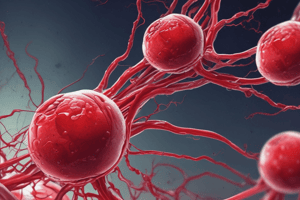Podcast
Questions and Answers
What is the first step in the process of normal haemostasis following injury to a blood vessel?
What is the first step in the process of normal haemostasis following injury to a blood vessel?
- Coagulation
- Platelet activation
- Platelet aggregation
- Collagen exposed (correct)
Which physiological process follows collagen exposure during normal haemostasis?
Which physiological process follows collagen exposure during normal haemostasis?
- Platelet activation (correct)
- Coagulation
- Platelet secretion
- Platelet aggregation
What primarily causes arterial thrombosis?
What primarily causes arterial thrombosis?
- Venous stasis
- Inappropriate activation of platelets (correct)
- Clotting factor deficiency
- Reduced blood flow
What occurs during the coagulation process related to thrombus formation?
What occurs during the coagulation process related to thrombus formation?
Which condition is a consequence of venous thrombosis?
Which condition is a consequence of venous thrombosis?
What symptom is commonly associated with peripheral arterial disease (PAD)?
What symptom is commonly associated with peripheral arterial disease (PAD)?
What is a recognized sign of ischaemic stroke resulting from arterial thrombosis?
What is a recognized sign of ischaemic stroke resulting from arterial thrombosis?
Which of the following is NOT a step in normal haemostasis?
Which of the following is NOT a step in normal haemostasis?
What is one common diagnostic method used to confirm deep vein thrombosis (DVT)?
What is one common diagnostic method used to confirm deep vein thrombosis (DVT)?
What is a common prevention measure for deep vein thrombosis (DVT)?
What is a common prevention measure for deep vein thrombosis (DVT)?
Which condition is commonly associated with an increased risk of developing thrombophilia?
Which condition is commonly associated with an increased risk of developing thrombophilia?
What is the risk of fatal pulmonary embolism (PE) associated with deep vein thrombosis (DVT)?
What is the risk of fatal pulmonary embolism (PE) associated with deep vein thrombosis (DVT)?
What is the inheritance pattern for Anti-thrombin III Deficiency?
What is the inheritance pattern for Anti-thrombin III Deficiency?
What symptom is commonly associated with arterial thrombosis in the case of a myocardial infarction (MI)?
What symptom is commonly associated with arterial thrombosis in the case of a myocardial infarction (MI)?
What is the increased risk of venous thrombosis (VT) for individuals with Protein C Deficiency?
What is the increased risk of venous thrombosis (VT) for individuals with Protein C Deficiency?
Which diagnostic method is NOT typically used to confirm arterial thrombosis in myocardial infarction (MI)?
Which diagnostic method is NOT typically used to confirm arterial thrombosis in myocardial infarction (MI)?
In which condition is the level of Protein S known to drop?
In which condition is the level of Protein S known to drop?
What treatment option is least appropriate for myocardial infarction related to arterial thrombosis?
What treatment option is least appropriate for myocardial infarction related to arterial thrombosis?
What percentage of individuals with Anti-thrombin III Deficiency are likely to develop a clot in their lifetime?
What percentage of individuals with Anti-thrombin III Deficiency are likely to develop a clot in their lifetime?
What is the prevalence of Protein S Deficiency in the population?
What is the prevalence of Protein S Deficiency in the population?
Which sign is NOT indicative of an ischemic stroke?
Which sign is NOT indicative of an ischemic stroke?
What is a common prognosis related to an ischemic stroke?
What is a common prognosis related to an ischemic stroke?
What major complication occurs in 40% of cases associated with venous thrombosis?
What major complication occurs in 40% of cases associated with venous thrombosis?
Which component is NOT part of Virchow's Triad contributing to venous thrombosis?
Which component is NOT part of Virchow's Triad contributing to venous thrombosis?
Which symptom is specific to deep vein thrombosis (DVT)?
Which symptom is specific to deep vein thrombosis (DVT)?
Emboli from venous thrombi typically travel to which location?
Emboli from venous thrombi typically travel to which location?
What is a major risk factor for the development of deep vein thrombosis (DVT)?
What is a major risk factor for the development of deep vein thrombosis (DVT)?
What percentage of individuals die before reaching a hospital after a first myocardial infarction (MI)?
What percentage of individuals die before reaching a hospital after a first myocardial infarction (MI)?
What conditions are associated with decreased levels of Protein S?
What conditions are associated with decreased levels of Protein S?
What is the consequence of estrogen therapy on tissue plasminogen activator (tPA) levels?
What is the consequence of estrogen therapy on tissue plasminogen activator (tPA) levels?
What caution should be observed before initiating estrogen therapy?
What caution should be observed before initiating estrogen therapy?
Which of the following is not a name used for Antiphospholipid Antibody Syndrome?
Which of the following is not a name used for Antiphospholipid Antibody Syndrome?
What percentage of healthy individuals are known to have antiphospholipid antibodies?
What percentage of healthy individuals are known to have antiphospholipid antibodies?
Which complication is associated with Antiphospholipid Antibody Syndrome in vivo?
Which complication is associated with Antiphospholipid Antibody Syndrome in vivo?
What condition is characterized by a raised platelet count above 150-400 x 10^9/L?
What condition is characterized by a raised platelet count above 150-400 x 10^9/L?
What is the primary defect in Paroxysmal Nocturnal Hemoglobinuria (PNH)?
What is the primary defect in Paroxysmal Nocturnal Hemoglobinuria (PNH)?
Which of the following is not classified as a myeloproliferative neoplasm?
Which of the following is not classified as a myeloproliferative neoplasm?
What effect does Paroxysmal Nocturnal Hemoglobinuria have on urine color in the morning?
What effect does Paroxysmal Nocturnal Hemoglobinuria have on urine color in the morning?
What is the increased risk of venous thrombosis (VT) for heterozygotes of Factor V Leiden?
What is the increased risk of venous thrombosis (VT) for heterozygotes of Factor V Leiden?
In which circumstance is activated protein C resistance (APCR) less likely to occur?
In which circumstance is activated protein C resistance (APCR) less likely to occur?
How does the Prothrombin G20210A allele affect prothrombin levels?
How does the Prothrombin G20210A allele affect prothrombin levels?
What is the inheritance pattern of Dysfibrinogenemia?
What is the inheritance pattern of Dysfibrinogenemia?
Which acquired risk factor increases the risk of thrombosis due to age-related changes?
Which acquired risk factor increases the risk of thrombosis due to age-related changes?
What is the strongest risk factor for acquired thrombophilia?
What is the strongest risk factor for acquired thrombophilia?
How does estrogen therapy specifically affect levels of protein S?
How does estrogen therapy specifically affect levels of protein S?
Which demographic groups are most prone to acquired thrombophilia?
Which demographic groups are most prone to acquired thrombophilia?
Which of the following conditions is associated with compression of the left common iliac vein?
Which of the following conditions is associated with compression of the left common iliac vein?
How does malignancy contribute to the risk of acquired thrombophilia?
How does malignancy contribute to the risk of acquired thrombophilia?
Flashcards are hidden until you start studying
Study Notes
Normal Haemostasis Stages
- Injury to blood vessel exposes collagen, initiating haemostasis.
- Platelet adhesion occurs as platelets bind to exposed collagen.
- Platelet activation follows, triggering a cascade of responses.
- Activated platelets secrete substances to recruit more platelets.
- Platelet aggregation leads to the formation of a platelet plug.
- Fibrin strands form to trap cells, creating a stable clot or thrombus.
- Coagulation occurs, solidifying the clot structure.
Arterial Thrombosis
- Major causes include inappropriate platelet activation due to:
- Atherosclerosis and plaque rupture exposing thrombogenic lipids.
- Often results in conditions such as:
- Myocardial Infarction (MI)
- Ischaemic Stroke
- Peripheral Arterial Disease (PAD)
- Symptoms for each include:
- Ischaemic Stroke: Sudden weakness, numbness, trouble speaking, and confusion.
- PAD: Leg pain or cramping during activity, sores that don't heal.
- MI: Chest pain radiating to arms/neck, shortness of breath, nausea, and sweating.
Diagnosis and Prognosis of MI
- Diagnosed with ECG, elevated troponin, and creatine kinase levels.
- Prognosis shows high mortality rates:
- 23% die before reaching the hospital,
- 13% during hospital admission,
- 10% within the first year after discharge.
Venous Thrombosis
- Common causes include:
- Immobility (e.g., bed rest, long flights)
- Prolonged postoperative recovery
- Symptoms include leg pain, swelling, redness, and heat.
- Embolisms typically travel to lungs causing pulmonary embolism (PE).
Diagnosis and Treatment of DVT
- Diagnosis via ultrasound, venogram, and elevated D-dimers.
- Treatment involves anticoagulation and thrombolytic therapy.
- Prevention methods include physical activity and support stockings.
Thrombophilia Overview
- Increased long-term risk of venous thromboembolism (VTE).
- Can be inherited (e.g., Antithrombin deficiency) or acquired (e.g., immobilization).
- Virchow's Triad components: Stasis, Endothelial damage, Hypercoagulability.
Inherited Disorders in Thrombophilia
- Antithrombin III Deficiency: Autosomal dominant, high clot risk (50% lifetime).
- Protein C Deficiency: Autosomal variation, 10-15 times increased risk of VT.
- Protein S Deficiency: Variability in function, 10 times increased risk of VT.
Risk Factors and Conditions
- Factor V Leiden: Increased risk for homozygotes (80 times).
- Prothrombin G20210A allele: Elevated prothrombin levels, 2-3 times increased risk.
- Essential Thrombocytosis: Elevated platelet counts leading to bleeding or thrombosis.
Acquired Thrombophilia Drivers
- Previous thrombosis increases risk by 5 times; older adults and obese individuals are more affected.
- Major surgeries elevate risk due to stasis and activity reduction.
- Hormonal factors (e.g., oral contraceptives) increase clotting factor levels and risk.
Specific Conditions
- Antiphospholipid Antibody Syndrome: Linked to increased arterial and venous thrombosis.
- Paroxysmal Nocturnal Hemoglobinuria: Lysis of RBCs with lifelong risk of thrombotic events.
- Myeloproliferative Neoplasms: Includes Polycythemia Vera with increased RBC production.
Summary on Thrombophilia
- Inherited Factors: Antithrombin, Protein C, Protein S deficiencies, Factor V Leiden, and more.
- Acquired Factors: Age, immobilization, surgery, malignancy, and hormonal therapies continue to increase VTE risk.
Studying That Suits You
Use AI to generate personalized quizzes and flashcards to suit your learning preferences.





